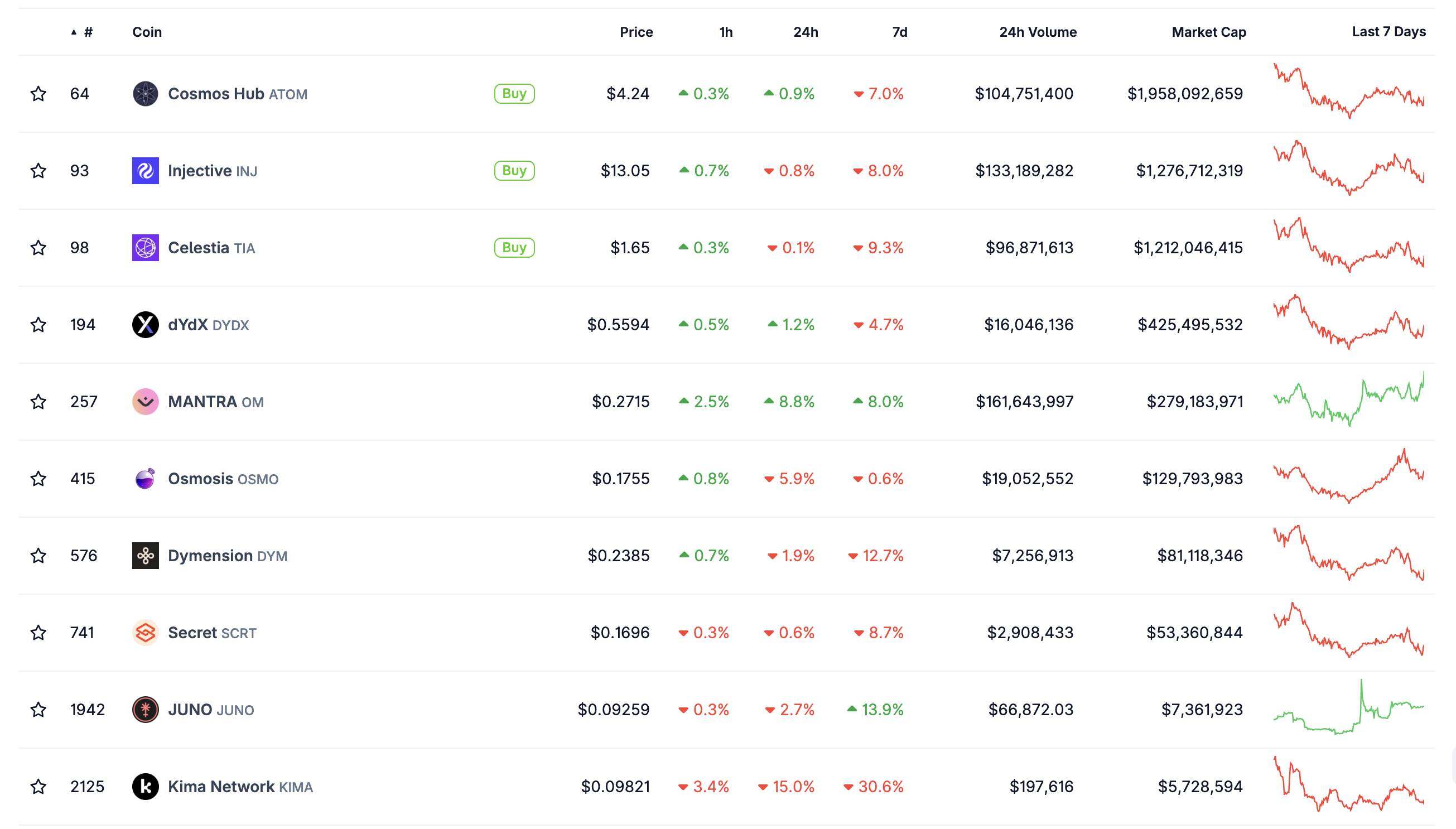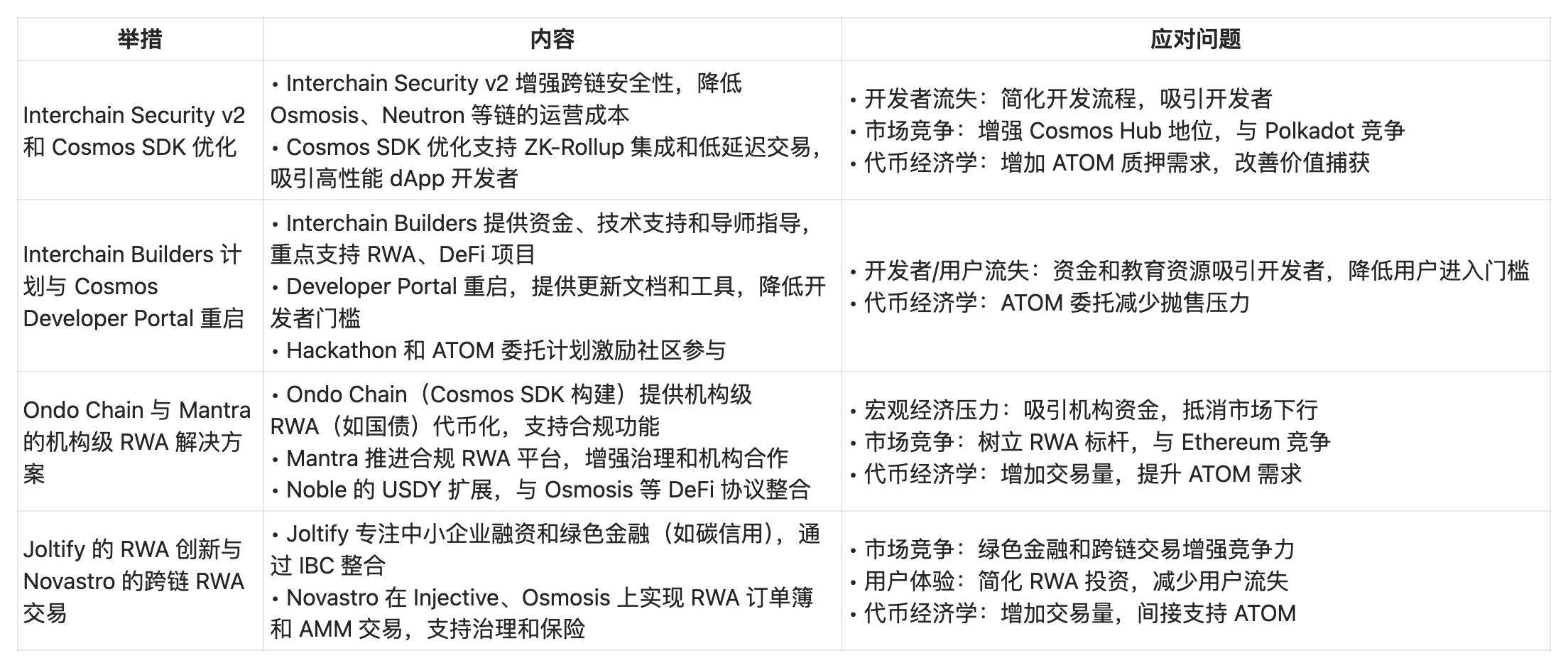Original author: Yanz, TechFlow
From the end of 2024 to the beginning of 2025, the performance of the Cosmos ecosystem attracted special attention, but not because of good news.
As of August 5, 2025, the price of Cosmos' core token, ATOM, has shrunk to $4.2, a 90% drop from its peak. Meanwhile, compared to the end of 2024, major projects like Osmosis (OSMO) have plummeted 79%, and JUNO's price has shrunk 82% to near zero. Even the relatively strong Injective (INJ) has fallen from $34 to around $12, not to mention the widespread declines seen for Kava, Evmos, Cronos, and Fetch.AI.

Cosmos, which once bucked the trend in 2022 and ranked second in TVL, is now facing a collective destruction of value. What happened to the Cosmos ecosystem, once considered the core of the blockchain internet? From a star project during the 2021 DeFi boom to its current sluggish market performance, what are the reasons behind this transformation?
When we carefully analyze its recent performance, we will find that there is a deeper background behind this big drop - it is not just as simple as market fluctuations.
Airdrop carnival, death loop
In early 2024, when news of the Celestia (TIA) airdrop spread throughout the crypto community, no one could have predicted that this feast of free wealth would become the beginning of a nightmare for the entire Cosmos ecosystem.
Celestia, a modular data availability network built on the Cosmos SDK, is deeply integrated with the Cosmos ecosystem through the IBC (Inter-Blockchain Communication) protocol.
A year ago in the spring, the price of TIA soared to a peak of $20.17, and social media was filled with stories of overnight wealth. However, the frenzy lasted only two months before a sell-off ensued, sending the price of TIA plummeting 91.9% to a current price of around $1.60.
Coincidentally, the collapse occurred in the entire Cosmos ecosystem.
The Celestia airdrop perfectly illustrates the vicious cycle of "hype-and-dump" within the Cosmos ecosystem. When the airdrop announcement was released, a flood of speculative capital poured in, driving prices up rapidly and creating a false sense of prosperity.
However, this growth based on expectations rather than actual value was doomed to be unsustainable. When early holders began selling to lock in profits, prices began to fall, and panic quickly spread, triggering even larger sell-offs and ultimately a price crash.
Osmosis experienced a similar process during the 2022 liquidity mining craze, with its price also falling from a peak of $11 to the current $0.17.
Each such cycle will consume the trust and financial foundation of the ecosystem. This short-term speculative behavior drives out real long-term builders and plunges the entire ecosystem into an impetuous atmosphere.
Puppet Emperor and Divided Kingdom
Ecological projects are unable to break out of the death cycle, and the price performance of ATOM, the core asset of the Cosmos ecosystem, has also encountered bottleneck problems.
Under the multi-chain parallel architecture, ATOM's positioning as network fuel has not formed an effective closed loop. Many sub-chains have independent native tokens and do not directly rely on ATOM, making it difficult for ecological traffic and value to flow back.
While the high inflation model with no cap on total supply incentivizes staking and governance participation, it also creates long-term pressure on the price of the token to dilute. More importantly, while Cosmos's free chain-building philosophy encourages innovation and competition, it also leads to fragmented traffic and independent projects, in stark contrast to Ethereum's model, which locks the majority of value in ETH.
ATOM became the puppet emperor of Cosmos, governance problems spread further, and the Federation did not benefit.
The JUNO project is the most typical case: in April 2022, the JUNO community discovered that a whale user circumvented airdrop restrictions through multiple wallets and obtained JUNO tokens worth approximately US$35 million.
After heated community debate, JUNO DAO officially voted to pass Proposal No. 20 on April 29, 2022, deciding to confiscate the tokens, and the decision took effect on May 4.
This controversial decision severely divided the community and led to a significant decline in investor confidence in the JUNO project's governance mechanisms. This governance failure not only failed to address the project's technical and market challenges, but actually accelerated its decline, with JUNO's price plummeting 99% from $43 to $0.09.
However, these are not the only problems facing Cosmos, nor are they even crises unique to Cosmos.
The "Midlife Crisis" of the Multi-Chain Ecosystem
When we talk about Cosmos’s predicament, we are actually analyzing the collective anxiety facing the entire multi-chain ecosystem— the profound disconnect between technological innovation and market adoption.
In April 2025, Cosmos ranked first among blockchain projects in terms of development events. This apparent lead cannot mask the gradual decline in the number of active crypto developers.

Source: developer report
Other multi-chain ecosystems are also sluggish: the number of Ethereum developers fell by 2.54%, the BNB Chain development index fell by 9.45%, Polygon, Arbitrum, Optimism and Avalanche fell by 10.35%, 7.62%, 6.82% and 12.08% respectively.
Polkadot ranked tenth with 3.4K developer activity, and its contributors decreased by 0.91% to 325. Faced with the slow response to JAM upgrades and market competition, the community even issued an urgent call of "React or die."
Multi-chain ecosystems face similar structural challenges:
- Lack of network effect: Compared with Ethereum, it lacks a sufficient user base and application scenarios to form a self-reinforcing ecological cycle
- Insufficient developer incentives: Although the technology is advanced, there is a lack of sufficient economic incentives to attract and retain outstanding development talent.
- Unclear market positioning: In the competition with Ethereum, these projects often fall into the dilemma of superior technology but lack of application
This inherent dilemma is further amplified by the current special market environment changes.
In the second quarter of 2025, the total market value of the crypto market exceeded US$3.5 trillion, but this round of growth was dominated by institutional funds, and institutions have a completely different investment logic: controllable risks, sufficient liquidity, and regulatory compliance .
For institutional investors seeking stable returns, Bitcoin and Ethereum are clearly more attractive than technologically innovative multi-chain projects. This shift in capital flows has directly led to the further marginalization of multi-chain projects in terms of financing and liquidity.
What’s even more serious is that the institutionalization process has brought about another unexpected consequence - the “Matthew effect” of infrastructure construction is accelerating.
Stablecoins are becoming the core infrastructure connecting traditional finance and the crypto world. However, this infrastructure development primarily revolves around established networks. As stablecoins become the fuel of the new financial system, multi-chain ecosystems find themselves on the fringes.
This dilemma has forced these ecosystems to re-examine their value propositions, shifting from pure technological competition to a pragmatic approach that focuses more on user experience and actual application scenarios.
This transformation is not only a necessity for survival, but is also likely to be the starting point of the next innovation cycle.
Crossroads: Rebirth or Fall
Standing at the time node of 2025, the Cosmos ecosystem is at a critical historical moment.
From the grand vision of the blockchain internet when the mainnet was launched in 2019, to the market's frenzy for interoperability when ATOM hit an all-time high of $44.70 in 2021, to the deep reflection when the price fell to around $3.5 in the bear market from 2022 to 2024, Cosmos has gone through a typical and unique growth trajectory for blockchain projects.
In this dark hour, although the data is bleak, Cosmos is indeed undergoing a profound self-revolution.

Different institutions have diverse expectations for the Cosmos (ATOM) ecosystem and price trends, with large divergences in short-term forecasts. CCN and Changelly are pessimistic, emphasizing the bearish pressure shown by technical indicators (such as RSI and moving averages), while CoinLore and CryptoNewsZ are more optimistic, expecting a bull market to push the price above $20–$40.
Regarding the uncertain future of Cosmos, ecological expansion, technological upgrades, market sentiment, regulatory environment and competitive pressure are all frequently mentioned considerations.
It cannot be denied that the actual effects of technological upgrades and governance reforms need time to be verified.
Competitive pressure from Layer-2 and other interoperability solutions persists, and the impact of Federal Reserve policy and geopolitical risks on the entire crypto market cannot be ignored. More importantly, this transition from idealism to realism is itself a painful process, requiring a delicate balance between technological innovation and market forces.
History tells us that truly great technologies and ecosystems are often born in the darkest moments. Cosmos, too, needs time to prove itself. Will it be the future or a deeper darkness that awaits?
- 核心观点:Cosmos生态陷入价值毁灭与信任危机。
- 关键要素:
- ATOM较峰值跌90%,OSMO等代币普遍缩水80%+。
- 空投投机引发“炒作-抛售”恶性循环,消耗生态资金。
- 多链架构致价值分流,高通胀模型稀释币价。
- 市场影响:多链生态面临机构资金边缘化风险。
- 时效性标注:中期影响。



